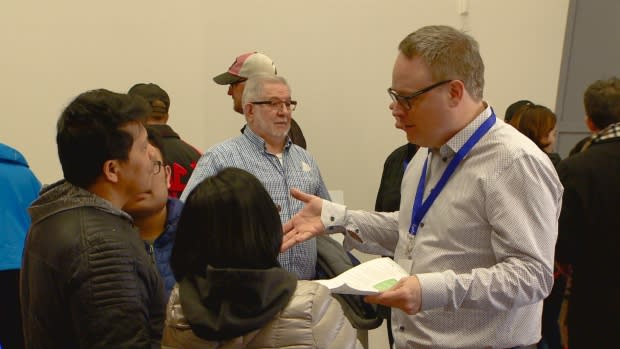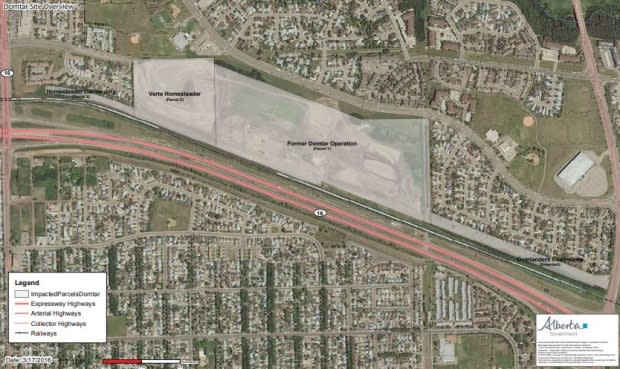'Pure anger': Residents neighbouring Domtar site respond to cancer rate findings
Jason Reagan has already booked an appointment to get tested for lung cancer.
He has lived beside the former Domtar site in northeast Edmonton for 13 years, along with his wife, Maureen, and their seven children.
This week, a provincial health assessment revealed higher than expected rates of three types of cancer — lung, breast and endometrial — among people who lived near the former wood-treatment plant for 10 or more years.
"Our main concern is what health risks we've already been exposed to. Is this actually going to hurt us in the future? Because if it is, they better get us out now," Reagan said.
Maureen and Jason joined dozens of other concerned residents at Clareview Community Recreation Centre on Saturday for the first of two information sessions organized by the Alberta government after the health risk assessment was made public.
'Pure anger'
The assessment was released alongside results of soil samples taken from around the former creotose plant in 2017 and 2018. The government said 183 samples from nearly 1,500 specimens had levels of toxic chemicals that exceed health guidelines.
The contaminated areas include the Greenbelt, an urban park corridor between the Yellowhead Highway and Overlanders community.
"I have pictures of my daughter taking her first steps in the Greenbelt. That's where they learned how to ride their bike," Maureen said.

The Reagan's backyard borders the Greenbelt. For years, it was the place for neighbourhood football games and their children's birthday parties.
The area was fenced off last year to avoid exposure to dangerous chemicals — dioxins and furans in particular. Maureen said she's left to wonder whether the years her children spent playing in the dirt or taking innocent bites of grass will have lasting health consequences.
"You don't know. You don't know what effects it will have on your health or your kids," she said.
"Pure anger, just everybody," Jason added.
Correlation vs. causation
The health assessment found the rates of other cancers, miscarriages and birth defects in the area were no different than the rest of the province. The government has also stressed that the data doesn't indicate why the rates of lung, breast and endometrial cancer are higher around the site.
"It doesn't mean that living in the area has caused those things. It simply means there's an association," said Deena Hinshaw, the Chief Medical Officer of Health in Alberta.

Hinshaw said the government will work with federal experts to investigate the health factors that might have contributed to the higher rates of cancer. Current and former residents will be contacted with more information about how to participate in the investigation.
Hinshaw also noted that officials put up fencing and dust control measures last year around the contaminated lands to reduce exposure.
'I would feel like someone dropped a bomb'
The Domtar site operated between 1924 and 1987, using creosote to preserve wood. The company did some remedial work on contaminated lands around the plant in 1994, before selling the site to 1510837 Alberta Ltd. in 2010.
The new owner and developer, Cherokee Canada, planned to turn it into a residential development. But they've since been locked in a back and forth with the province over the contaminated land.
Edmonton city councillor Aaron Paquette said he spoke with constituents who are concerned about their health and their future in the community in light of the latest studies.
"I would feel like someone dropped a bomb," he said. "The last thing I should be worried about is some kind of contamination that would threaten the things that I thought were going to be possible for me in this area."

The companies are fighting orders issued by Alberta Environment and Parks to clean up the site and surrounding area. The findings of the Environmental Appeals Board are being reviewed by Minister Shannon Phillips.
The government has said remediation will begin once ground conditions improve in the spring.
"We as the government are stepping in immediately to take action to clean up the properties to an appropriate level," said Randall Barrett, an executive director with Alberta Environment and Parks.
The Reagans said the value of their home dropped by $30,000 last year after the Greenbelt was deemed a contaminated area. The couple is concerned their property value might not recover.
"If we wanted to try to get away from the contamination, we're going to have to take a loss on our house. Can we do that and keep our kids safe?" Maureen said.
But Jason and Maureen don't want to relocate the family home.
"It would be hard if I had to leave. I love my neighbours. I love how quiet it is," Maureen said. "It is a great place to raise our kids."
The second government information session will be held at the Clareview Community Recreation Centre on Thursday.

